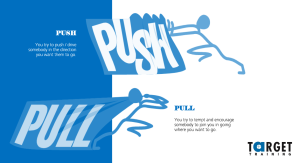How winning offers and proposals are written
I often find myself in the business section of the book store and I’m always struck by how cleverly these books position themselves. Titles like “How to Have A Good Day” or “The Art of Thinking Clearly” seem to speak directly to me and this is the reason I pick them up and sometimes even buy them. If you are involved in writing offers and proposals (RFQ’s, tender responses) you are looking to create a similar impact – you want the reader’s attention and interest from the moment they pick up the document. The secret to doing this, just as with business books, is to make them ‘reader-oriented’. Over the years we have worked with many companies that have great products and services but sometimes find it challenging to write commercial offers which appeal to readers. In this post we will explain exactly what ‘reader-oriented’ means and how to achieve it.
What do readers want to read about in an offer?
Think for a minute; if someone sends you a proposal for a product or service they want you to buy, what do you want to read in it?
Now read this quote: “Don’t come into my office and tell me about the perfect solution you have. Instead, tell me how you can solve my business problem and then I’m all ears!” Max Bittner, CEO Lazarda
Every proposal or offer exists to solve a problem, which your client is unable to solve on their own. So, as Max says, make sure your client’s problem or challenge is front and centre in your proposal. This means starting with a detailed and accurate description of the problem. You want your reader to think “This organisation understands my business and its challenges” because this will establish your credibility to solve their problem right from the start. It sounds obvious I know…and yet when running proposal writing workshops I am almost always asked “But where do I write about us and what we do? Normally we start with this!”
Key Learning Point 1
If you want to get your proposal read, start by talking about them not you.
What will they actively read?
Proposals have many different elements and different stakeholders will focus on different parts; legal will study your T&C, finance will look at your figures, procurement will study your value statement. But the three most important elements, and probably the ones that will be read by the decision maker, are:
1. The title
A good title can create a great first impression and get your proposal higher in the pile of many proposals. And the trick is to make the title speak to the reader. Compare these 2 different titles for the same proposal and ask yourself – which proposal would you read first?:
- Proposal from Company X for Internet Connectivity Services.
- Creating Opportunities for Company Y’s Customers by Connecting Remote Islands in the Western Pacific.
An effective title will contain 3 things; name the client, include a verb (to indicate what the proposal will do) and an outcome (which of course is focused on the client’s business).
2. Contents page
The contents page is there for a reason. At a quick glance, a reader can assess what’s in your proposal, whether it is worth reading, and where to start. Spending time on the contents page will also help you to:
- Plan the proposal before you start writing it
- Check that nothing is missing
- Order the sections of your report so they are logical and connected
- Craft headings for each section
Again, it’s all about the language. Compare “Context and Background” to “What Problem is Company Y Trying to Solve?”. The second heading is more specific and engaging, and it uses a question which is a good way of getting readers’ attention. You probably noticed that this post uses questions for each section.
3. Executive summary
The Executive Summary is critical – it may be the only part of the proposal read by a decision maker, before she or he passes it to specialist teams with their comments and recommendations. Think of the Summary as the text you read on the back of a book; it should tell you what’s in the book and encourage you to read it.
Executive Summaries should be short (I would recommend no more than 1 page) and written in clear and simple language; avoid technical or specialist language as your reader could be more of a generalist if they are a C-level decision maker. Giving it to someone else to read is a great way to get feedback and make improvements.
The next section in this post will give you ideas on how to craft the content of your Executive Summary. You can also find help and advice on writing in clear and simple English and editing your writing in these two posts:
Key Learning Point 2
Focus on the 3 elements of the proposal that will make the biggest impression. Craft them to grab your reader’s attention with how your product or service will benefit their business.
Is there a winning structure for offers?
Yes there is! There is a structure that we recommend and organisations we have worked with tell us it works. N.O.S.E. can be a powerful structure to engage and persuade your reader because it starts with answering the question “Why should I read this proposal?” just as Max Bittner explained in the quote your read earlier. In fact, it would be a great structure for your Executive Summary!
Here’s the structure, described from two perspectives; what you write about and what your client is looking for:
NEEDS
- You: What problems/needs does the client have?
- Client: I want to see that you understand my problem
OUTCOMES
- You: If the problems/needs are addressed, what would be the positive result for the client’s business?
- Client: I want to know how this will benefit my business
SOLUTIONS
- You: What is the product/service will provide this outcome?
- Client: I want to believe you can solve my problem
EVIDENCE
- You: How will you deliver the solution on time, to budget and with quality?
- Client: I want to trust that you can do what you say
Key Learning Point 3
Use a structure that persuades by starting with the client’s needs before you explain your solution.
More writing skills
- The Importance of Writing in Plain English
- Quick Tips of Editing Your Own Work
- The basics of reader-oriented writing
















